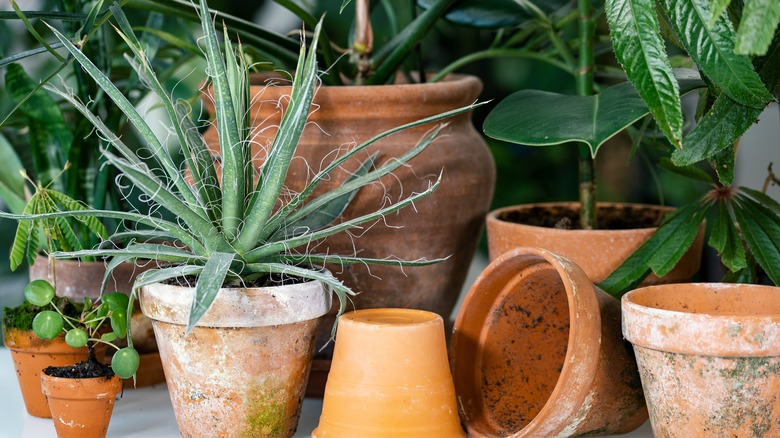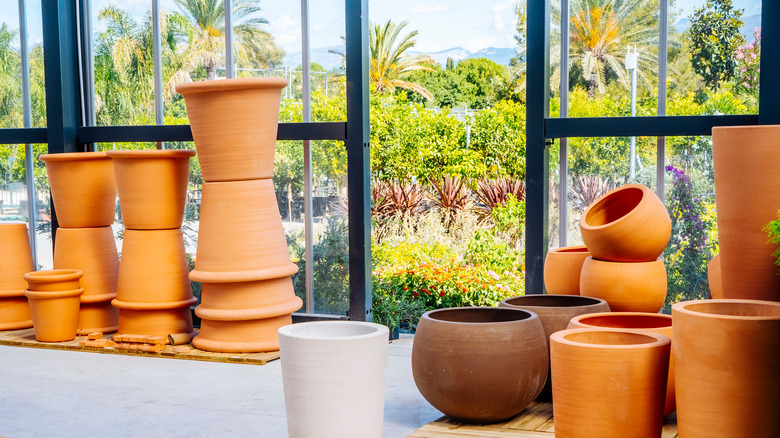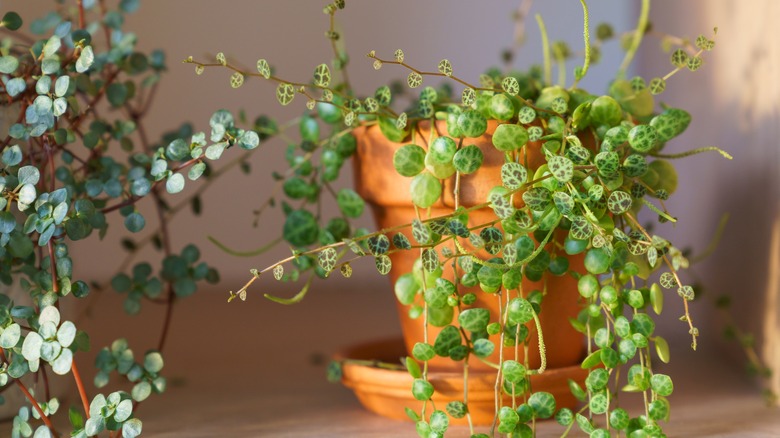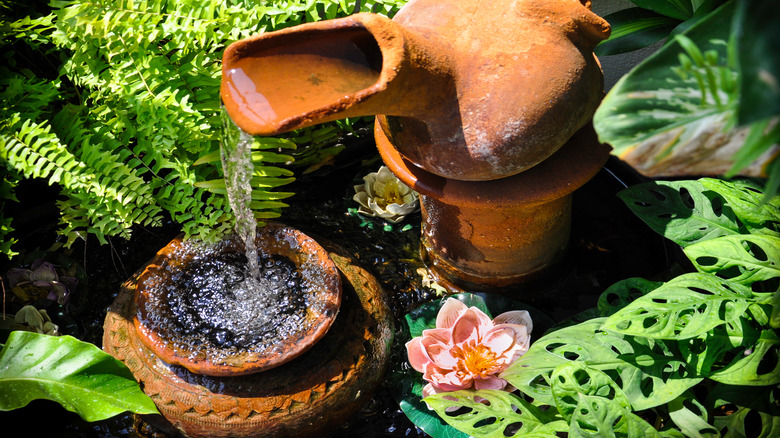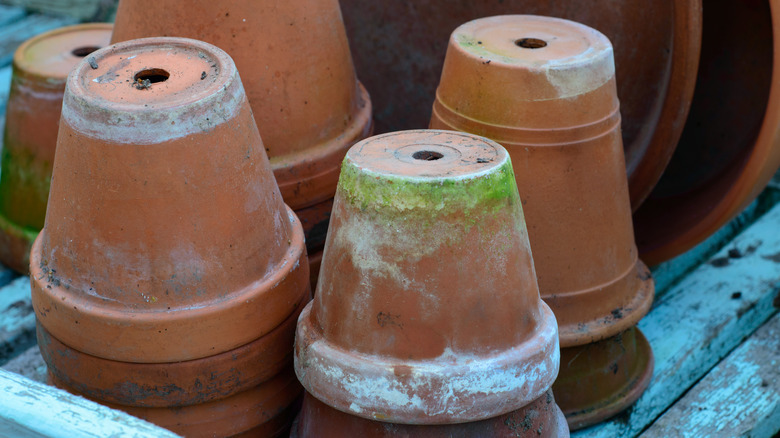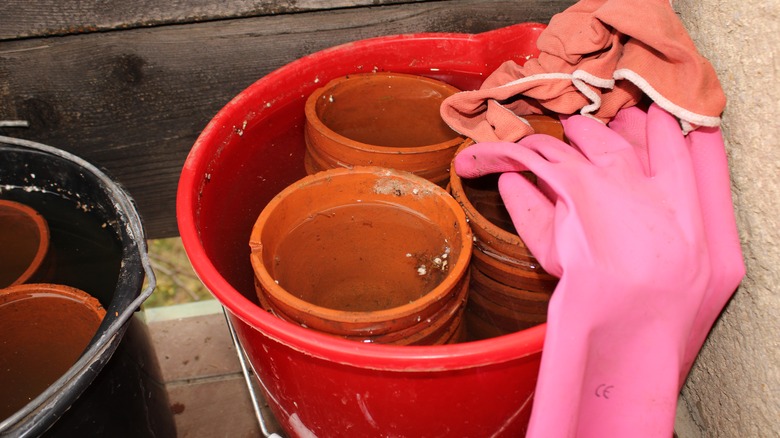5 Tips For Gardening With Terracotta Pots
Terracotta is the Italian word for baked earth, which instantly explains why it's the classic choice for container gardeners and houseplant enthusiasts who love the look of the earthy reddish clay and the sturdiness of a natural material that can be used over and over for decades. Britannica says the term can describe all fired clay; however, it most often refers to some vessel, like a container, pot, or bowl. In ancient times, terracotta was used to make bricks and roof tiles. The clay is porous, and it takes on its signature orange hue when it gets fired. Sometimes you'll find painted or glazed terracotta, but more often than not, it will remain unglazed and natural.
Terracotta clay pots are undeniably aesthetically pleasing; however, there's more to their advantages than just good looks. Per GreenUpside, natural clay is a healthy choice for your plants because it regulates the moisture in the soil. The pots are sturdier than thin plastic alternatives and much less likely to crack. Furthermore, Ellementry deems terracotta eco-friendly and eco-sustainable due to its longevity, ease of manufacture, and ability to withstand high heat. Could you ask for better reasons to use these pots for your plants? We think not! Of course, there are best practices for everything, so we've put together some helpful tips to keep in mind when container gardening with terracotta pots.
Pick a high quality terracotta pot
As the saying goes, not all terracotta is created equal. Living Color Garden Center points out that the biggest problem with cheap terracotta pots is that they're way too easy to chip or break. When you flip the pot over, cover the drainage hole with your thumb, and tap the pot's base, you want to hear a resonating ring. If all you get is a lackluster thump, place that cheap knockoff back on the shelf and keep shopping.
For the best of the best, stick with the original makers and look for proven Italian brands such as Seibert & Rice, which comes straight from the Tuscan town of Impruneta, or Terrecotte San Rocco (via Eye of the Day Garden Design Center). Their products are made of 100% Galestro clay and can last for over a century. Provided they are draining correctly, high-quality clay pots will resist harm from frost throughout the winter freeze in temperatures as low as -20 degrees Fahrenheit. They'll also remain as sturdy as ever when the spring thaw arrives. It's no exaggeration that with a well-cared-for, quality terracotta pot, you'll have an heirloom to pass down to the next generation, along with your love of plants.
Choose plants that thrive in terracotta pots
Because terracotta is naturally porous, it soaks up and then releases much moisture in the potting soil. Considering that overwatering is one of the most common ways we humans kill our innocent little darlings, as helpfully noted by Missouri Botanical Garden, it's mostly a good thing that a terracotta pot tends to the issue of excessive moisture. That said, plenty of plants prefer to live in evenly damp soil. It's important to factor in an individual plant's water requirements before potting it in terracotta over plastic.
Water-retaining cacti and succulents, of course, rank high on the list of terracotta-appropriate greenery, per Living Color Garden Center. Orchids come in a close third with other relatively drought-tolerant and easy-to-please plants, such as philodendrons, peperomias, and hoya plants. On the flip side, clay pots are unlikely to make a happy home for irises, ferns, elephant ears, or calla lilies. If all you've got is a clay pot or you want to decorate your home like the movie "Under the Tuscan Sun" — we get it, we loved that movie too — you'll need to stay on top of watering those moisture-loving plants.
Saturate your terracotta pot before transplanting
Keeping in line with the fact that clay dries out quickly, soaking your terracotta pots overnight before potting a new plant can help everyone start with as much retained moisture as possible, which may go so far as to reduce transplant shock. The director of marketing and e-commerce at Pistils Nursery, Jesse Waldman, agrees. In an interview with Well+Good, Waldman says, "Classic terra cotta pots are unglazed and unsealed. The clay itself is porous, meaning that it will actually absorb water. So pre-soaking saturates them in advance, which is going to slow this process down."
An internet search on the topic will surely bring up conflicting opinions regarding this method, for example, Gardening Etc. considers it a waste of time and water. However, the outlet notes that another way to increase moisture retention in terracotta is to paint the inside of the pot as a way to clog the pores. When it comes down to it, pre-soaking your pots is hardly a practice that will cause any harm, so you might as well do it, especially if you lean in the direction of forgetting about your plants for weeks on end as opposed to overwatering them. Growers at Ohio Tropics suggest a 30-minute warm water bath, remarking that it makes a noticeable difference for them.
Scrub off salt and mineral deposits
Over time, a crusty film will likely build up around the edges and down the sides of your terracotta pots. This usually white residue comes from salt, calcium, and other mineral deposits. The buildup can look fantastic and give off an antique or vintage patina vibe; however, these mineral deposits can harm your plants. According to the Iowa State University Extension and Outreach, mineral residue creates an environment where diseases thrive, and salty edges cause dehydration to the stems that come into contact with them.
You'll find faux-aged terracotta pots for sale through retailers like Etsy and Amazon. If the process is happening naturally in your container garden, it's worth staying on top of it for the overall health of your plants because it could be a sign that your soil contains too much salt, notes Bloom Sprouts. This often occurs when gardeners hydrate their plants with hard tap water, or it can result from improper fertilizing; it can cause leaf burns. Aside from consulting a local expert regarding fertilizers, an easy way to nip the residue problem in the bud is by cleaning your pots with vinegar and a stiff brush. A 25% solution will do the trick (one part vinegar to four parts water); soak for an hour, then scrub-a-dub.
Disinfect terracotta pots between uses
Washing wipes away germs but disinfecting is what kills viruses and bacteria, explains The Centers for Disease Control and Prevention. Before moving a new plant into a previously used terracotta pot, go beyond vinegar and disinfect the pot with bleach, rubbing alcohol, or alkyl dimethyl benzyl ammonium saccharinate (Lysol), recommends the University of Minnesota Extension. This is especially important if the first plant suffers from diseases or pest infestations. A product like Lysol should not be diluted and can be sprayed directly onto the pot and left to air dry. With household bleach, 10% is the solution ratio to shoot for, meaning one part bleach to nine parts water.
The University of Minnesota notes that offending germs will die instantly, but it won't hurt to soak a pot for a few minutes. The Old Farmer's Almanac offers a friendly reminder that bleach is a rather severe chemical; wear gloves and even eye protection anytime you use it. Also, don't forget to wear clothes you won't mind getting covered with bleach spots! Regarding rubbing alcohol, remember that it's flammable, then rub it over the pot's surface without diluting it. This won't be the most efficient option, but it'll be better than nothing. If you're not cool with the harsh chemical plan, the Old Farmer's Almanac advises soaking terracotta pots between uses in vinegar for a few hours at the very least.
